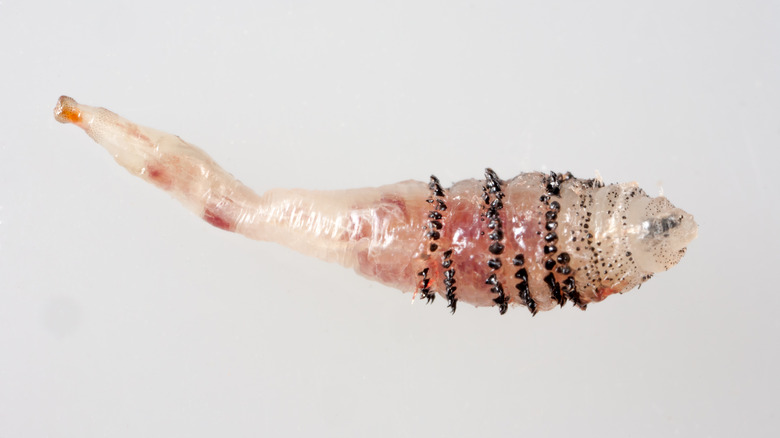Why This Researcher Raised A Botfly
If you're ever tempted to check out some of the more gross and uncomfortable corners of the internet, you could do a lot worse than videos of people removing botflies from under their skin. As the University of Florida explains, botflies are large flies that resemble bumblebees, known scientifically as Dermatobia hominis. When the insect is a fully-grown adult — well, you don't have to worry about it much. But in places where the critter lives, such as the tropical rainforests of South America, you do have to be on guard against getting one of its eggs under your skin. That's because it can hatch there and grow to its larval stage and have to be removed. Just ask an unnamed Florida woman who, according to the academic paper "Human Botfly: A Case Report and Overview of Differential Diagnosis," came home from a vacation in Belize with a hard lump under her skin. Long story short, it was a botfly larva, and it would have to be removed.
The removal of botflies is, to put it charitably, uncomfortable (some victims would likely say excruciating). Though not pathogenic, a botfly infection is going to be anything but pleasant; as such, getting ahead of these infestations is a key area of research in some entomological circles. Researcher Piotr Naskrecki, keen to learn more about the critters, deliberately grew one under his own skin.
Piotr Naskrecki, Gonzo Biologist
It takes a special kind of scientist to devote himself or herself to the creepy, the gross, and the things that many find disgusting. But when it comes to entomology (the study of insects), Piotr Naskrecki is all about it. As Harvard University explains, he sees beauty in them; as such, he's published more than 30 academic papers and at least two books. Further, his photographs of bugs have appeared in several major publications.
By 2020, Naskrecki had taken up researching in and advocating for conservation in Mozambique's Gorongosa National Park. As he wrote for a post on the park's website, "As a nature photographer and writer, I am involved in projects that promote Gorongosa's biological riches to the world. This includes writing a field guide to its wildlife and a planned documentary about Gorongosa's insect life."
A few years earlier, what may be Naskrecki's career-defining (at least, in terms of this particular topic) took place. As Science Alert reports, in 2014 in Belize, he, like the unnamed Florida woman mentioned above, managed to get botfly eggs injected into him. But being a scientist who is committed to science at all costs, he allowed at least one to mature. Why? Because he wanted to see what happened, apparently.
'I Felt An Almost Father-Child Relationship'
Normally, when someone realizes they're infected with botfly larvae, getting them out is top priority. In fact, there's even a crude machine designed for this sort of thing that extracts the critter, somewhat quickly and somewhat painlessly, which you can see in the video linked in the next sentence. Piotr Naskrecki, on realizing that some of the mosquito bites he'd suffered in Belize in 2014 weren't mosquito bites at all, but rather botfly larvae, he said nuts to that and decided to let one of them live, according to this video from PBS, via YouTube.
"I could see something moving in there," he said of one of his wounds. He decided to let the creature live through this portion of its life cycle — it took about two months, according to Science Alert, and once the insect was ready to emerge from the scientist's skin on his own, the process took about 40 minutes. "It was not particularly painful, in fact, I probably would have not noticed it if I had not been waiting for it, as the botfly larvae produce painkillers that make their presence as unnoticeable as possible," he said. He turned the whole experience into a documentary film, which you can see here, via Vimeo.


